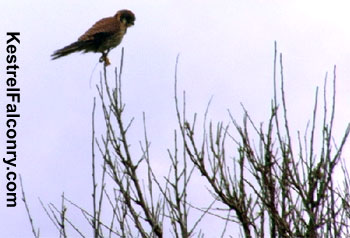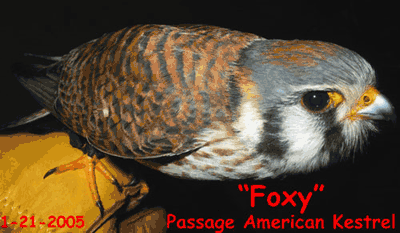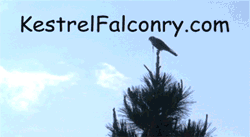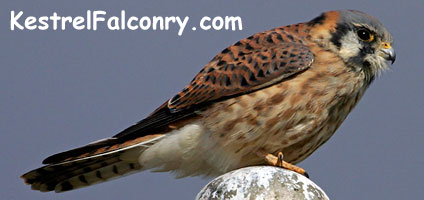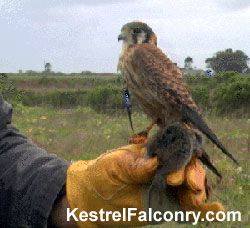About Kestrels
Kestrels are AWESOME! They are a small falcon with many characteristics of larger raptors and often regarded as a beginner bird but they are really so much more.......
About American Kestrels in Falconry
American Kestrels are classified as a true falcon. But…they act like a Falcon, Hawk and even Accipiter at times, all together in one small package. The small size of American Kestrels make it perfect for countryside and city/urban falconry. The main prey as a falconry bird is European Starlings and House Sparrows which can be found in backyards, farms and basically at every McDonalds and Costco parking lot across the country. Don’t consider these small falcons limited to parking lot hunting or “car hawking”, they do really well in vacant lots and freshly mowed fields as well. American Kestrels will sometimes even dive/crash into brush breaking tail feathers very similar to the way Accipiters do.
Typically, Falcons hunt birds and ducks while Hawks hunt ground quarry like rabbits and squirrels. The American Kestrel is one of the exceptions as they hunt various prey including small birds, rodents, and insects. They don’t always eat everything they catch. Over the years, I have seen my kestrels catch a wide variety of prey and then take a bite and just drop it as if they didn’t like the taste. I can only assume they do this in the wild without a falconer watching.
List of prey items I have seen my kestrels catch:
Various Small Birds: The main goal of hunting with an American Kestrel is to catch European Starlings and House Sparrows because these are invasive species and will outcompete native birds for food and habitat/territory. So not only are you hunting wild prey for your American Kestrel to eat but you are also helping native species survive. This means you don’t want to hunt native species with your kestrel. As a falconer you are responsible for identifying and knowing the difference between pest birds and native species. The slips you setup for your bird should be as clear as possible of native species.
Rodents: Field Mice, Rats, Gophers (Eaten and enjoyed but be careful of places that would try to poison rodents.)
Amphibians: Frogs and Salamanders (Taste tested and dropped, not eaten.)
Reptiles: Alligator lizard - She grabbed the tail and the lizard got away by dropping its tail. She let go of the tail after taste testing it. Another Kestrel I had caught a small gopher snake and carried it up to a waist high shrub and did the taste and drop routine. Snake got away safe.
Insects: Crickets, Grasshoppers, Potato bugs, different kinds of beetles, Dragonflies, Worms and probably more types of insects that were eaten quickly in one bite before I could see what it was. Some of the insects were tasted and then dropped like the stink beetles. Today as I write this she caught a large black and yellow Bumble Bee and ate half of it on my glove.
Kestrels share many traits with both Falcons and Hawks. Typically, Falcons have long talons for grabbing birds and if they don’t dispatch their prey on impact they tend to use the notch in their beak to get in between the vertebrae. Hawks usually have smaller feet but they are very thick and muscular to crush the prey almost like a snake that is coiled around its prey. American Kestrels again can do both. They use a variety of methods to finish the prey.
Another great aspect to the American Kestrel in falconry is their ability to hover/kite in the air. Only a few other raptors have really mastered hovering and kiting in the air. Kestrels ability to hunt using different methods makes them a very fun and versatile hunting bird. Traditionally, Falcons are flown from a stoop and hawks are flown from the fist, "waiting on style", or a T- perch. Kestrels fall again in-between and can be hunted in a variety of ways.
The Main Styles of Hunting with American Kestrels
"From the Fist"This style of hunting is from the glove where you walk along and kick bushes with the Kestrel looking around for prey. The usual result from this form of hunting as shown in the video is going to be mostly insects caught. Kestrels usually need more height and speed to catch their prey, usually from up in a tree or telephone wire which is much taller than your glove. Kestrels can also suprise birds feeding on the ground unaware of the Kestrels approach because they just see you the walking along and don't see the falcon on your glove. You can also hide the falcon behind you and pull it out when in range of the feeding birds. Kestrels are so small they really can be hidden easily.
"T-perch or Pole hunting"This style of hunting is from pole with a perch on the end that you carry around kicking bushes and trying to flush game. This is very similiar to hunting from the glove but this gets your falcon more height. More height means better positioning during the slip. This form of hunting can more easily get birds and rodents than from the glove but they do love the large grasshoppers!
"Waiting On/Hovering"This is one of the forms of hunting that kestrels can do that other raptors just don't do as well. Kestrels naturally hover looking for rodents and various prey. It can be hard to get your Kestrel to regularly do this but it is possible. By "Waiting On" or Hovering the kestrels gets even more height and they are already flying which makes them even more ready for some prey to get flushed. When you get your Kestrel waiting on just freeze for a minute at first sometimes they can be already onto something and you might flush it the wrong way. This method of hunting provides rodents and birds. If they are "Waiting On"/Hovering they are after something much larger than a grasshopper.
"Car Hawking"This is the most controversial and dangerous forms of hunting with American Kestrels. In a car you don't have the height as from a pole but you do have the speed. Kestrels can very easily catch pest birds through car hawking but you need to be careful of totally random dangers like passing cars and neighborhood cats that appear out of nowhere and run off with your kestrel before you can even get out of the car. Another danger is not watching where you are driving because the slip was so awesome. I highly recommend having a designated driver, someone to drive for you while Car-Hawking. (I bet car-hawking is safer than texting while driving. LoL) Also, Check with your state to make sure you can legally "Car-Hawk". Some states consider "Car-Hawking" to be "hunting from a motor vehicle" and against the law. You can really rack up many kills this way and make a small dent in your invasive bird species population.
"Barn/Shed Hunting"This can be a good way to get your kestrel started hunting or "entered" because they do have a greater advantage in a shed/barn. Finding sheds and barns that have prey can be tough but it does happen. Since you are in the Barn/Shed with the prey and kestrel you get to see the chase closer up and in your face, unfortunately the chase is usually very short.
"About Flushing"
Even if you know there isn't some prey in a bush it doesn't hurt to kick it. Kicking a shrub/bush near you might just flush out prey 20 feet away at another bush that isn't even connected. There is more prey around than you think. Get out there and FLUSH!
Submit your Kestrel Content!
If you would like to submit your Kestrel Videos or have us link to your Kestrel Blog or anything Kestrel Related then please email us at KestrelFalconry@KestrelFalconry.com We are primarily interested in American Kestrels in action although we would love to see all kinds of kestrels.

